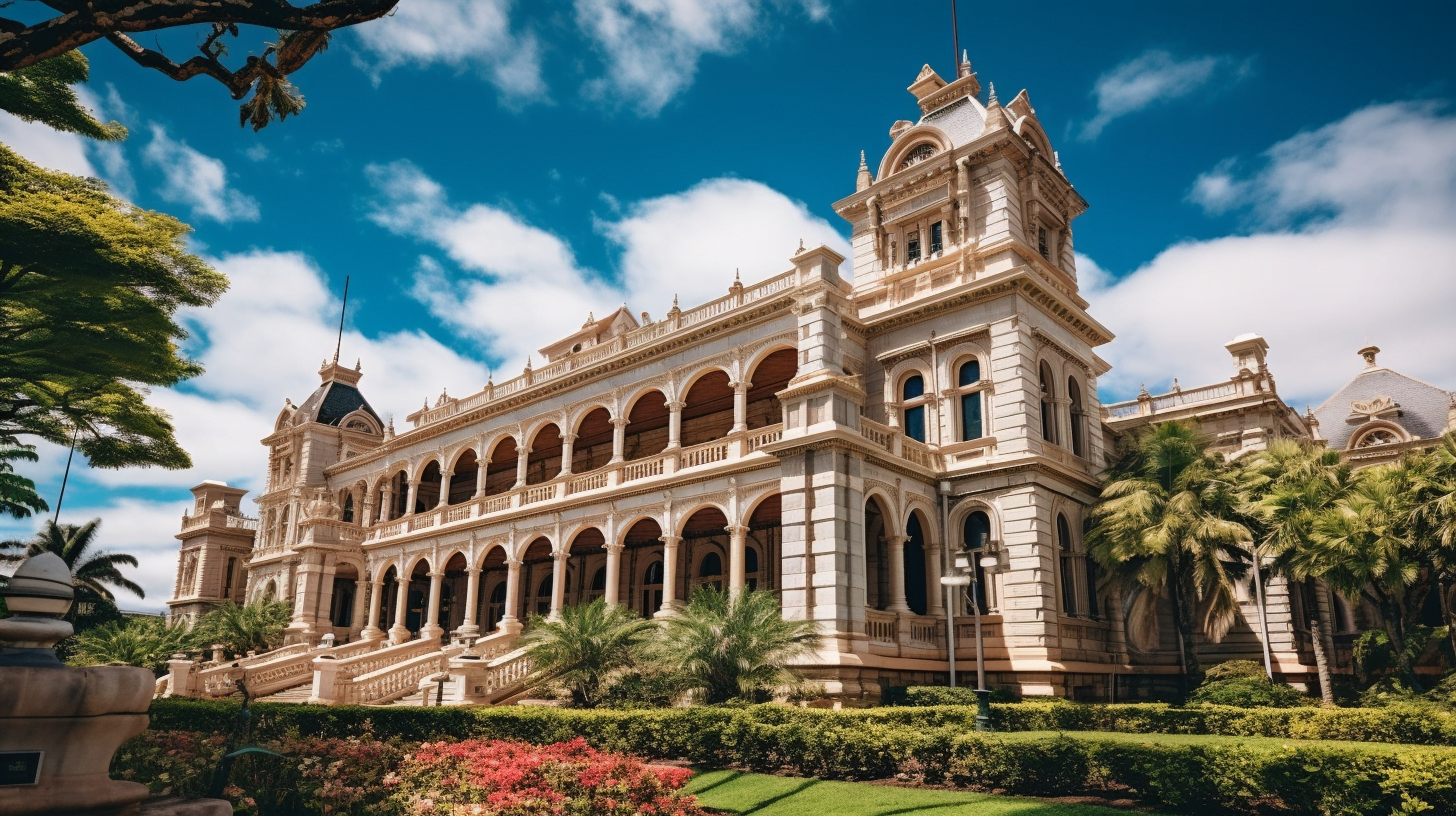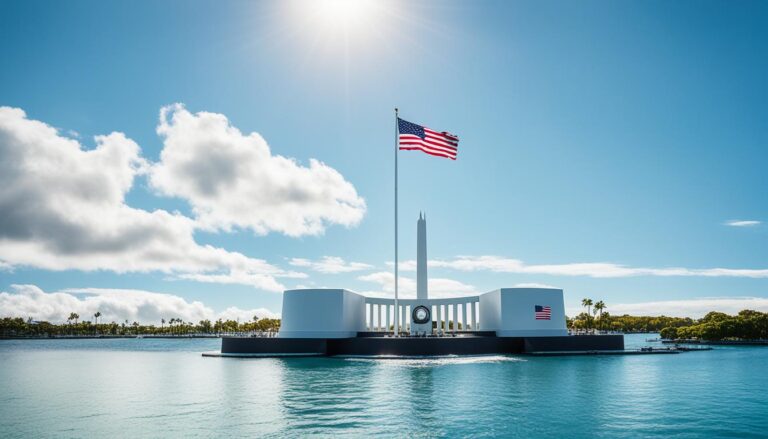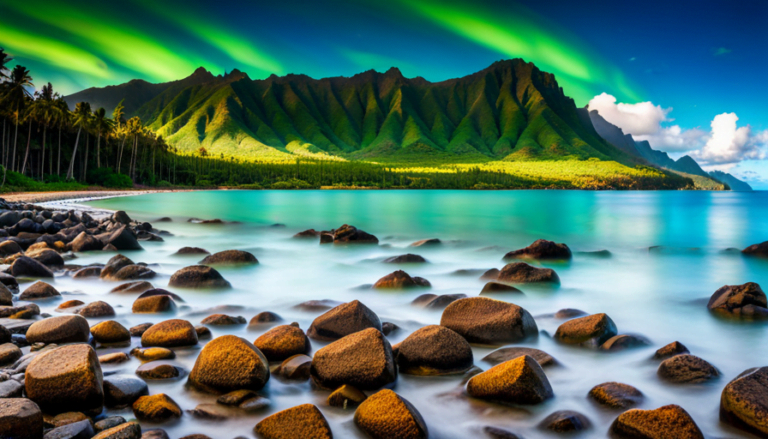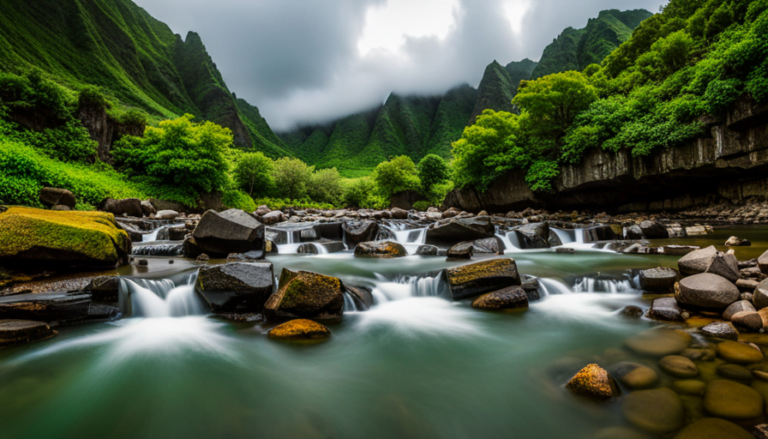🏝️ Uncovering Oahu’s Past: From Ancient Temples to Modern Tourist Destinations 🌺
If you’re a history buff, Oahu is the place to be. This island is rich in history and culture, with plenty of historical attractions to explore.
From the World War II-era Pearl Harbor to ancient Hawaiian temples and royal palaces, Oahu has something for everyone.
The island’s historical attractions are not only fascinating, but also provide a glimpse into the island’s past and its people.
Whether you’re interested in learning about the island’s ancient Hawaiian culture or the events that shaped modern Hawaii, Oahu’s historical sites will not disappoint.
So grab your sunscreen, put on your walking shoes, and get ready to take a journey through Oahu’s rich history.
Key Takeaways
- Oahu has a variety of historical attractions, including Pearl Harbor, ‘Iolani Palace, Bishop Museum, and ancient Hawaiian temples and ruins.
- Specific historical attractions on the island include Pacific Aviation Museum, Polynesian Cultural Center, and Pearl Harbor-related sites such as the National Memorial Cemetery of the Pacific and Honolulu Memorial.
- Visiting these historical attractions allows for a deeper understanding and appreciation of Hawaiian culture and history, as well as an opportunity to pay respects to those who served our country.
- Historical attractions in Oahu offer a chance to relax at the beach or take a dip in the ocean while learning about the island’s past.
Pearl Harbor
You can’t visit Oahu without experiencing the emotional and historic impact of Pearl Harbor. This site, which was once a peaceful naval base, was attacked by the Japanese on December 7, 1941, causing the United States to enter World War II.
Today, visitors can explore the Pearl Harbor National Memorial, which includes the USS Arizona Memorial, the USS Bowfin Submarine Museum and Park, and the Pacific Aviation Museum. The USS Arizona Memorial is a poignant reminder of the lives lost during the attack, as it sits above the sunken battleship where over 1,100 sailors and Marines were killed. Visitors can take a boat ride to the memorial and pay their respects to those who lost their lives.
The Bowfin submarine and Pacific Aviation Museum offer an in-depth look at the technology and tactics used during the war, as well as the bravery of those who served. After experiencing the history of Pearl Harbor, head to ‘iolani palace to explore the royal roots of Hawaii.
Iolani Palace
If you’re interested in exploring Hawaii’s rich history, a visit to Iolani Palace should definitely be on your itinerary. This iconic building, as the former residence of Hawaii’s monarchy, offers a unique glimpse into the island’s past. You can take a tour of the palace to learn about the royal family and their customs, as well as the political and social climate of the time.
Whether you’re a history buff or just looking for an educational and fascinating experience, a trip to Iolani Palace is definitely worth your time.
Touring the Former Residence of Hawaii’s Monarchy
Located in downtown Honolulu, the Iolani Palace is a must-visit attraction for anyone interested in the rich history of Hawaii’s monarchy. As you step inside, you’ll be transported back in time to the days of King Kalakaua and Queen Liliuokalani.
The palace, built in 1882, was the official residence of Hawaii’s monarchy until the overthrow of the Hawaiian Kingdom in 1893. It was then used as the state capitol for many years before being restored to its former glory as a museum.
Touring the former residence of Hawaii’s monarchy is a fascinating experience, with knowledgeable guides leading you through the grand halls and lavish rooms adorned with intricate details and priceless artifacts. You’ll learn about the palace’s unique architecture, which blends Hawaiian and Western styles, and about the monarchs who once lived there.
After your visit, continue learning about the island’s history by exploring other historical sites and museums throughout Oahu.
Learning About the Island’s History
Immerse yourself in the rich history of Hawaii by visiting the various museums and cultural centers scattered throughout the island. Start by checking out the Bishop Museum, which is the largest museum in Hawaii and houses an impressive collection of artifacts, exhibits, and interactive displays that showcase the history, culture, and natural environment of the islands.
You’ll learn about everything from the formation of the islands to the arrival of the Polynesians, the reign of the Hawaiian Monarchy, and the impact of Western contact on the islands.
Next, head over to the ‘Iolani Palace, which was the official residence of the Hawaiian Monarchy for over 80 years. Here, you’ll be transported back in time to the days of King Kalakaua and Queen Lili’uokalani, and you’ll get a glimpse into their lavish lifestyles, political struggles, and the fascinating history of the Hawaiian Monarchy.
Lastly, don’t miss out on the Pearl Harbor Historic Sites, which includes the USS Arizona Memorial, the Battleship Missouri, and the Pacific Aviation Museum. These sites offer an opportunity to learn about the events of December 7th, 1941, and the impact of World War II on Hawaii and the United States.
As you delve deeper into the history of Hawaii, you’ll discover the island’s rich cultural heritage that dates back centuries.
In the next section, we’ll explore some of the ancient Hawaiian temples that are still standing today.
Ancient Hawaiian Temples
If you’re interested in exploring the ruins of sacred sites and learning about the indigenous people of the island, then ancient Hawaiian temples are an essential stop on your itinerary. These temples were once the epicenter of Hawaiian religious and cultural life, and they offer a glimpse into the rich history and traditions of the Hawaiian people.
From the towering stone structures of the heiau to the intricate carvings of the ki’i, there’s no shortage of fascinating details to discover at these ancient sites.
Exploring the Ruins of Sacred Sites
You’d think that exploring the ruins of sacred sites would be a somber experience, but it’s actually quite fascinating.
As you wander through the remnants of ancient Hawaiian temples, you can’t help but be awed by the architecture and engineering skills of the island’s indigenous people. The intricacy of the stonework and the alignment with celestial bodies show the deep spiritual connection that the Hawaiians had with their land and their gods.
But it’s not just the physical structures that are impressive. As you learn about the customs and beliefs of the Hawaiians, you begin to understand the importance of these sacred sites to their way of life.
The ruins are a window into a culture that was deeply connected to the natural world and the spiritual realm. By exploring these sites, you can gain a greater appreciation for the history and traditions of the Hawaiian people.
And that’s just the beginning of what you can learn about the island’s indigenous people.
Learning About the Island’s Indigenous People
As you explore Oahu’s historical attractions, you’ll come across stories and legends that have been passed down through generations, giving you a glimpse into the rich cultural heritage of the Hawaiian people. One way to learn more about the island’s indigenous people is by visiting the Hawaiian Hall at the Bishop Museum. Here, you can view exhibits that showcase the history, language, and culture of the Hawaiian people.
The Hawaiian Hall is split into three sections: the Kahili Room, the Pele Room, and the Polynesian Room. In the Kahili Room, you’ll see a collection of feather standards that were used as symbols of Hawaiian royalty. The Pele Room highlights the legend of the Hawaiian volcano goddess Pele and her significance in Hawaiian mythology. Lastly, in the Polynesian Room, you’ll learn about the voyaging history of the Polynesian people and their migration to Hawaii. With interactive exhibits and displays, the Hawaiian Hall offers an immersive educational experience that will leave you with a deeper understanding of Hawaii’s indigenous people.
Transitioning into the subsequent section about the Bishop Museum, you’ll find that it is the largest museum in Hawaii and home to a vast collection of artifacts, artwork, and natural history specimens.
Bishop Museum
If you’re interested in viewing artifacts and exhibits that showcase Hawaiian culture and history, then you’ll definitely want to check out the Bishop Museum. This museum is home to a vast collection of items, including ancient Hawaiian artifacts, royal regalia, and even a planetarium.
As you explore the exhibits, you’ll have the opportunity to learn about the history of the Hawaiian Islands and the people who once lived there. This makes for a truly enriching experience.
Viewing Artifacts and Exhibits
When visiting Oahu’s historical attractions, don’t miss out on viewing the fascinating artifacts and exhibits that showcase the island’s rich cultural heritage.
The Bishop Museum, for instance, houses a vast collection of Hawaiian artifacts, ranging from traditional clothing to ancient weapons and tools. You can also explore the museum’s impressive natural history exhibits, which include specimens of rare plants and animals that are native to Hawaii.
Other historical attractions on the island offer equally engaging exhibits. At Pearl Harbor, for example, you can view the USS Arizona Memorial, which honors the sailors who lost their lives during the attack on Pearl Harbor. The Pacific Aviation Museum is another must-see attraction, featuring an impressive collection of vintage aircraft and exhibits on the history of aviation in the Pacific.
Whether you’re interested in Hawaiian history, World War II, or aviation, Oahu’s historical attractions have something for everyone. With so much to see and learn, you’re sure to come away with a deeper appreciation for the island’s rich cultural heritage and fascinating history.
As you explore Oahu’s historical attractions and view the fascinating artifacts and exhibits on display, you’ll also have the opportunity to learn about Hawaiian culture and history. From the ancient Hawaiian way of life to the impact of colonization and immigration, the exhibits offer a window into the island’s past and present.
By immersing yourself in the stories and traditions of Hawaii, you’ll gain a deeper understanding of the unique culture and way of life that make this island so special.
Learning About Hawaiian Culture and History
You’ll gain a deeper appreciation for Hawaiian culture and history by immersing yourself in the fascinating exhibits and artifacts on display. Oahu has various historical attractions that showcase the island’s rich cultural heritage, from the Polynesian Cultural Center to the Bishop Museum. At the Polynesian Cultural Center, you can witness the traditions of the Pacific Islands come to life through dance performances, interactive exhibits, and demonstrations of ancient skills such as spear throwing and fire making. The center also offers educational tours that explore the history of Hawaii and its people, as well as cultural activities such as lei making and hula dancing.
Meanwhile, the Bishop Museum houses the largest collection of Hawaiian artifacts in the world, including ancient tools, weapons, and artwork. The museum’s exhibits provide insight into the daily lives of Native Hawaiians, as well as the significant events and individuals that have shaped Hawaii’s history. One of the most popular exhibits is the Hawaiian Hall, which features a recreated village and an impressive display of royal regalia. By visiting these attractions, you’ll not only learn about Hawaii’s past, but also gain a better understanding of its present and future.
As you continue your exploration of Oahu’s historical sites, make sure to also visit the National Memorial Cemetery of the Pacific. This solemn site honors the sacrifices of those who served in the United States Armed Forces and is a poignant reminder of the costs of war.
National Memorial Cemetery of the Pacific
Located in the heart of Honolulu, the National Memorial Cemetery of the Pacific, also known as the Punchbowl Cemetery, is a resting place for over 50,000 veterans and their families, making it a unique and solemn destination to pay respects.
As you enter the cemetery, you’ll be greeted by the grand entrance and the stunning view of the city. Here are three things you should know about this historical attraction:
- The cemetery was established in 1949, and the first interment was made on January 4, 1949.
- The cemetery is the final resting place for veterans of every war that the United States has fought since World War I, including the Korean War and the Vietnam War.
- The cemetery is also the site of the Honolulu Memorial, which was built to honor the sacrifices and achievements of the US Armed Forces in the Pacific during World War II.
Visiting the National Memorial Cemetery of the Pacific is a moving experience that allows you to pay your respects to the brave men and women who have served our country.
As you leave the cemetery, you can continue your journey to Waikiki Historic Trail, where you can learn more about the history and culture of Hawaii.
Waikiki Historic Trail
Exploring the Waikiki Historic Trail offers a glimpse into the rich cultural heritage of Hawaii. As you walk along the path, you will pass by 23 different points of interest, each marked by a bronze plaque. The trail stretches for 2.5 miles and takes approximately 2 hours to complete.
Along the way, you’ll learn about the history of Waikiki and the native Hawaiians who once lived here. One of the most interesting points on the trail is the Kuhio Beach Hula Mound. This is where King David Kalakaua revived the hula in the late 1800s.
You can also visit the Royal Hawaiian Hotel, which was built in 1927 and is considered the first luxury hotel in Waikiki. After exploring the Waikiki Historic Trail, make your way to the nearby Fort DeRussy Beach Park, where you can relax on the beach or take a dip in the ocean.
Fort DeRussy Beach Park
When visiting Waikiki, don’t miss out on the chance to relax at Fort DeRussy Beach Park. This beautiful spot is perfect for sunbathing or swimming, with crystal clear waters and soft sand that will make you never want to leave.
The park’s location at the foot of Diamond Head also provides stunning views of the surrounding landscape, making it a great place to take in the natural beauty of Oahu. But Fort DeRussy Beach Park isn’t just a pretty spot to lounge around in.
It also has a rich history as a former military fortification, with bunkers and gun emplacements that date back to World War II. Visitors can explore these historical features and learn about the important role that this area played in the defense of Hawaii.
So, whether you’re looking for a relaxing day at the beach or a chance to delve into the island’s past, Fort DeRussy Beach Park is a must-see attraction in Waikiki.
Conclusion
So, you’ve explored the rich history of Oahu’s historical attractions, from the somber Pearl Harbor to the grand Iolani Palace.
You’ve marveled at the ancient Hawaiian temples and learned about the island’s cultural heritage at the Bishop Museum.
You’ve paid your respects at the National Memorial Cemetery of the Pacific and walked the Waikiki Historic Trail.
And you’ve relaxed at Fort DeRussy Beach Park, enjoying the sun, sand, and sea.
But as you reflect upon your journey through Oahu’s past, you can’t help but feel a sense of irony.
For all of the island’s storied history, it’s now a bustling tourist destination, overrun with crowds of visitors seeking sun, fun, and relaxation.
The same beaches that were once battlegrounds are now populated with sun loungers and cocktail bars.
The same ancient temples that were once revered are now merely photo opportunities for Instagram.
Perhaps this is the nature of progress, and there’s nothing inherently wrong with enjoying the fruits of modern tourism.
But as you leave Oahu, you can’t help but wonder what the island’s ancestors would think of their sacred sites being reduced to mere attractions.
In a way, the very history that draws visitors to Oahu is also the history that has been lost in the pursuit of profit.







